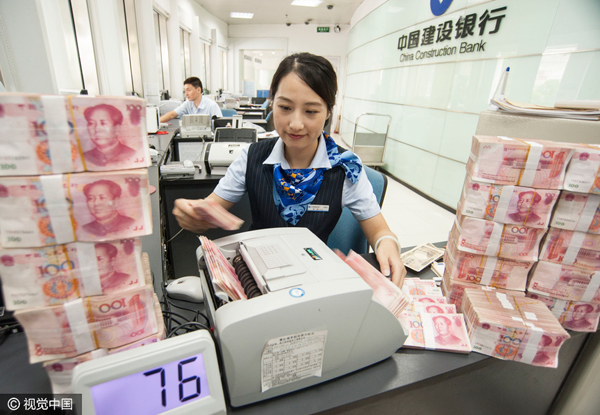Foreign exchange scrutiny to prevent speculative outflows
 |
|
A clerk counts 100 yuan banknotes at a branch of China Construction Bank in Nantong, East China's Jiangsu province, Sep 21, 2016. [Photo/VCG] |
Since the beginning of 2017, the State Administration of Foreign Exchange has strengthened the regulations on individuals' purchase of foreign currency. According to the regulations, Chinese individuals that intend to purchase foreign currency have to provide detailed information of how they intend to use the foreign currency when applying; purchasing foreign currency to buy property overseas and invest in foreign countries are prohibited.
These regulations have been called new, but in fact they are not. The authority is only strengthening the implementation of existing regulations and making people aware it will punish violations. Individuals can still enjoy their $50,000 annual exchange quota for the normal forex purchase purposes such as overseas study or travel.
Under the circumstances that China's capital account is not completely open yet, it is necessary to enhance foreign exchange scrutiny through improving the management of foreign exchange purchases to cope with any speculative capital outflow.
The regulations work well, but the decisive factor in the long-term foreign exchange trend is the difference between the country's economic growth rate and inflation rate. Considering China's gradually slowing down GDP growth, the US Federal Reserve's interest rate hike and the stimulation policies such as the tax reductions that US President Donald Trump may implement, it is the general trend that global capital is flowing to the developed economies.
To change the renminbi's long-term depreciation trend, China has to accelerate its economic transformation and improve its efficiency. Before the market reaches a consensus that China's economic fundamentals have improved, depreciation of the renminbi is still possible.
The renminbi's inclusion in the International Monetary Fund's Special Drawing Rights basket of currencies is regarded as a milestone in the process of the Chinese currency's internationalization. But the process faces the Triffin Dilemma, whereby the trade deficit is the main means of exporting the renminbi from the perspective of international balance of payments, but this will increase the expectation of depreciation, which goes against the core requirement of international currency to maintain a stable currency value.
At the present stage China has a huge current account surplus. Therefore, gradually opening China's capital account, encouraging overseas investment, accelerating reform of the foreign exchange rate and financial system, as well as building a more developed financial market are all significant measures during the process of the renminbi's internationalization.
China's foreign reserves fell for the sixth month to about $3.01 trillion last December from $3.05 trillion last November, which has drawn public concern. In the past year, the decline in China's forex reserves has mainly been due to the central bank's efforts to stabilize the renminbi's exchange rate. China still has more than $3 trillion forex reserves, which is sufficient for the central banks' forex operation.
Given US Fed has stated there will be two or three interest rate hikes in 2017 and the strong economic recovery in Western developed countries, in the short term the trend for capital outflows from China will not change on a large scale, and China's forex reserves will continue to decline.
China's GDP growth slowed to 6.7 percent in 2016. The ever-increasing production costs in China and the diminishing of the demographic dividend that China once enjoyed are undermining the country's export competitiveness. In addition, the supply-side structural reform still has a long way to go and the country lacks sufficient endogenous demand. All these factors will impose pressures on the renminbi's future exchange rate.
But in the long run the market will fully respond to the Fed's interest rate hikes and developed countries' economic recovery. And with the deepening implementation of domestic policies such as deleveraging and destocking, the reform uncertainty will be remarkably reduced. Thus it can be expected the effects of supply-side structural reform will gradually appear, which is conducive to reversing the expectations for the renminbi's depreciation.
The author is a finance researcher at Central University of Finance and Economics.
- Stricter financial supervision needed before exchange rate flows freely
- Stabilizing exchange rate
- Yuan exchange rate hits 6-year low amid volatility of other currencies
- Chinese premier says RMB exchange rate to stay basically stable
- China largely succeeds in RMB exchange rate reform over past year
- China makes progress in exchange rate flexibility: US Treasury official
- China reaffirms stable exchange rate, moving forward structural reform
- 'China can keep RMB exchange rate stable'






















